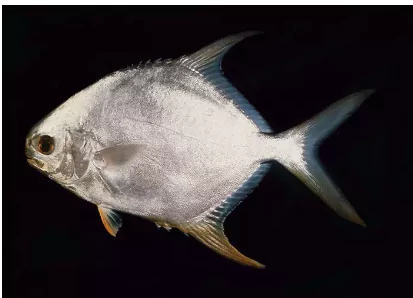In a recent effort to bolster marine resources and foster sustainable fishing practices, twenty-thousand pompano (Trachinotus blochii) fingerlings were released off the coast of Vizhinjam, Kerala as part of an artificial reef and sea ranching project.
Sea Ranching and Artificial Reef Project
- Objective: The primary goal is to restore fishery resources and support sustainable fishing through fingerling release.
- The project involves releasing one million pompano and cobia fingerlings at ten designated locations along the Thiruvananthapuram coastline as a follow up to the Artificial Reef Project.
- Implementation: The initial batch of 20,000 pompano fingerlings was released approximately 1.5 nautical miles off Vizhinjam.
- Additionally, artificial reef modules funded under the Pradhan Mantri Matsya Sampada Yojana (PMMSY) have been deployed across 42 sites in 33 fishing villages within the district.
- Funding and Support: Supported by the National Fisheries Development Board (NFDB), the ₹3-crore project received approval in March and is managed by the State Fisheries Department with fingerlings cultivated at the Ayiramthengu Fish Farm.
Enroll now for UPSC Online Course
About Sea Ranching
- Sea Ranching/ Ocean Ranching is releasing fingerlings raised in controlled environments to replenish oceanic and lacustrine ecosystems, supporting long-term resource availability for fishing communities.
- Purpose: Sea ranching is a government-led approach, focused on restoring fish populations and promoting marine sustainability.
- Species Cultivated: Varied species, including oysters, mussels, carp, trout, and tilapia, are grown in hatcheries and released into natural waters, allowing them to mature in their native habitats.
- Technology Used: Modern ocean ranching relies on sophisticated breeding, rearing, and release technologies developed since the 1970s. These innovations help optimize species survival and integration into the wild.
- Benefits:
- Economic: Replenishes fish stocks, aiding the fishing industry and local economies.
- Social: Provides sustainable income sources for fishing communities.
- Ecological: Supports environmental protection and ecosystem regeneration.
About Artificial Reefs
- Definition: Artificial reefs are human-made structures placed in aquatic environments to improve ecological conditions, providing habitats for marine species and enhancing fishery productivity.
- Uses:
- Restoration: Helps restore ecosystems, including coral reefs.
- Fish Production: Increases fish stocks for small-scale fishers.
- Wave Protection: Helps mitigate coastal erosion by absorbing wave energy.
- Habitat Creation: Provides food, shelter, and breeding grounds for marine species.
- Recreational Benefits: Supports eco-tourism, snorkeling, and recreational fisheries.
- Bottom Trawling Restriction: Deters harmful bottom trawling near shorelines.
- Materials: Reefs are constructed using durable materials like concrete, steel, and purpose-built modules in diverse shapes, such as triangular or floral designs.
- Examples:
- CMFRI Project (India): Aids fish availability while reducing costs for small-scale fishers.
- Dubai Reefs: Utilizes 3D printing to build an extensive artificial reef network.
- Pearl of Dubai: Features an artistic, city-themed reef near Dubai’s coast.
Significance of the Initiative
- This combined sea ranching and artificial reef initiative not only supports marine biodiversity but also enhances local fisheries by increasing fish stocks and establishing stable marine habitats.
- The project aligns with the government’s sustainable development goals, safeguarding marine life and empowering coastal communities through sustainable fishing practices.
Check Out UPSC Modules From PW Store
About Silver Pompano

- Overview: The silver pompano, a tropical species also known as the snubnose pompano, is valued for mariculture due to its adaptability and market demand.
- Appearance and Habitat: Characterised by its torpedo-shaped body, the silver pompano inhabits the warm waters (25-29°C) of the Indo-Pacific, particularly around coral and rocky reefs.
- Economic Value: This high-value species fetches ₹300–₹400 per kg in India, supporting local fishers and fish markets.
- Harvesting Practices: Typically caught with drag nets, pompano are immediately chilled to maintain freshness, ensuring quality for the seafood market.
Additional Reading: PM MSY
![]() 14 Nov 2024
14 Nov 2024


